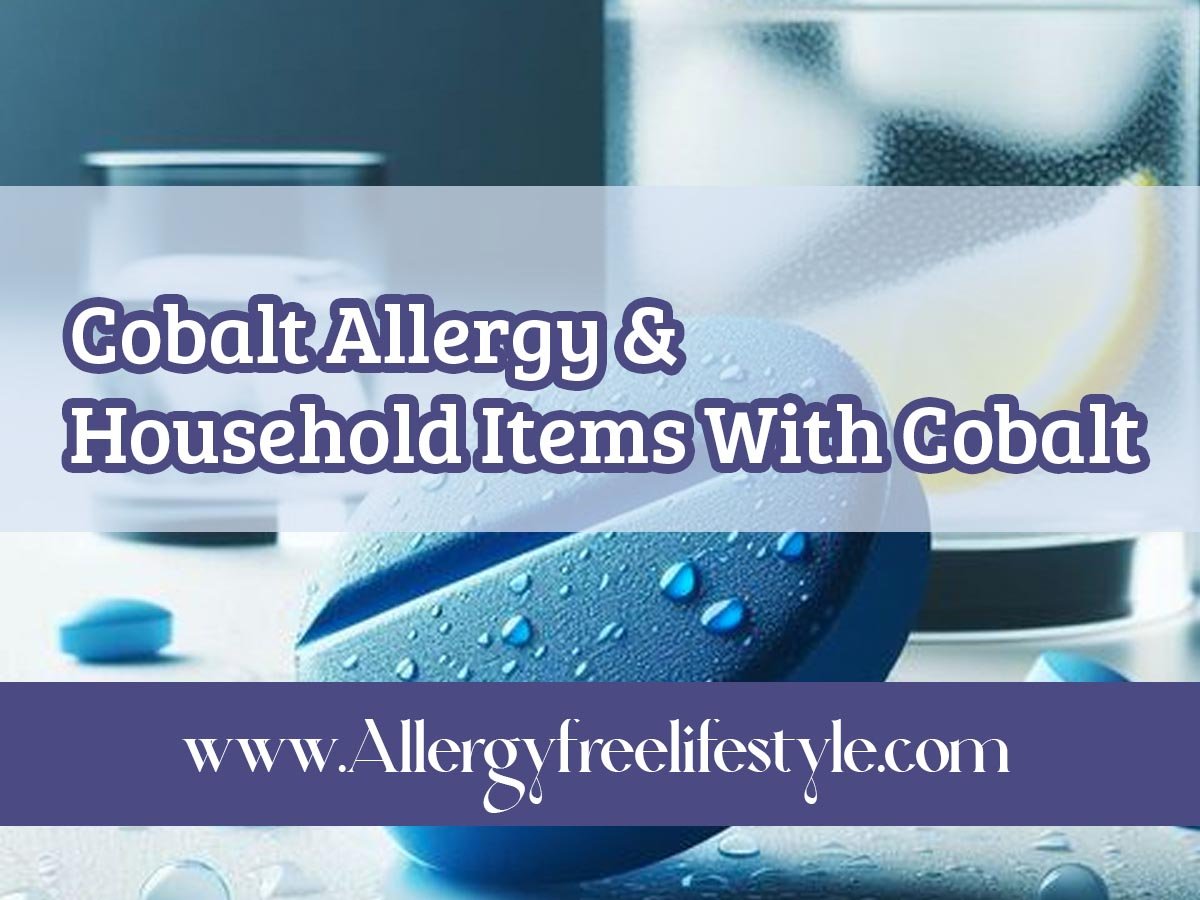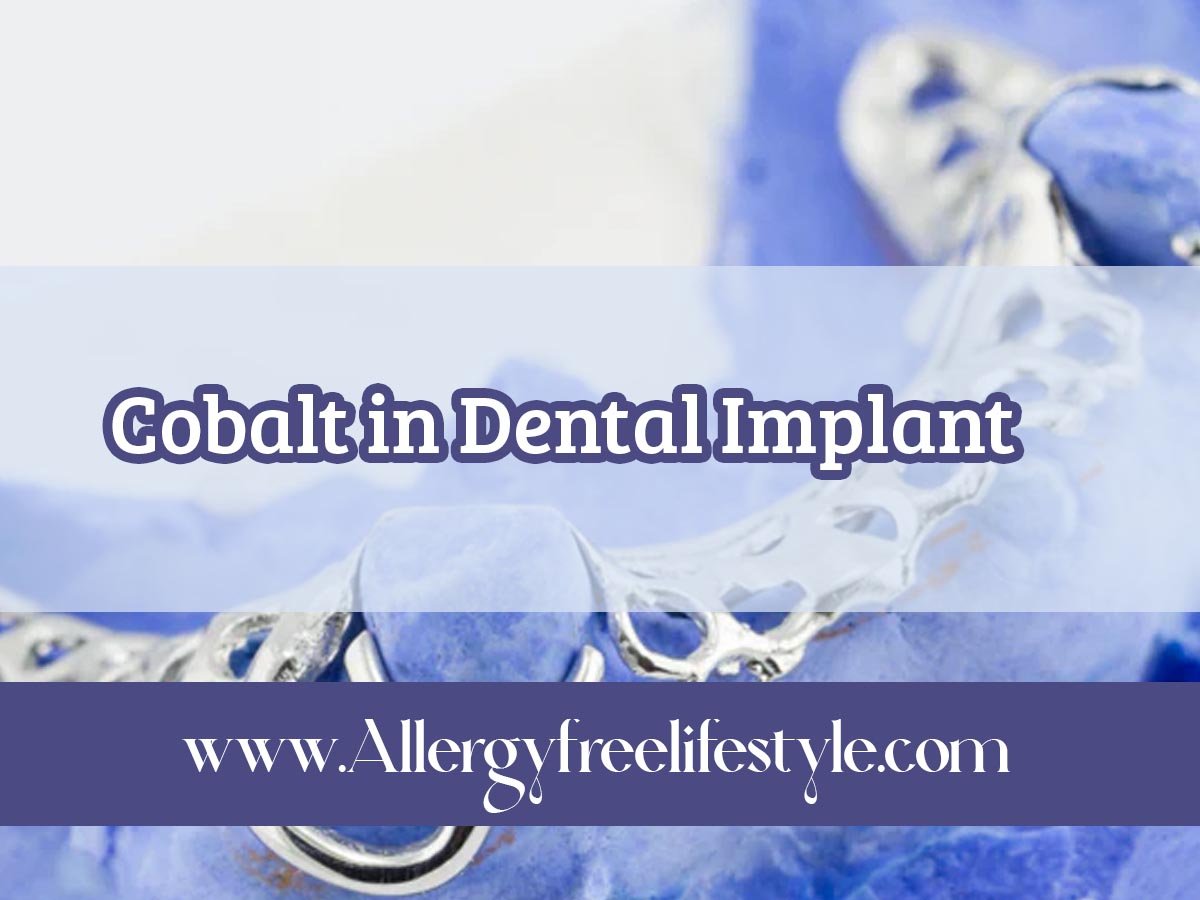
In the vast spectrum of allergic reactions, metal allergies occupy a unique and often overlooked niche, with cobalt allergy standing out as a particularly intriguing condition. Cobalt, a metal found naturally in the environment and widely used in various industries, can become a source of discomfort and health concerns for those sensitive to it. Understanding cobalt allergy, its triggers, and effective management strategies is crucial for those affected. This article aims to shed light on cobalt allergy, emphasizing the importance of recognizing and managing metal allergies for better health and well-being.As a bonus, we’ve included 100 facts about cobalt at the end of this article
What is Cobalt Allergy?
Cobalt allergy emerges when the immune system erroneously identifies cobalt as a harmful substance, leading to allergic reactions upon exposure. This condition underscores the complex relationship between humans and the metals that permeate their lives, often in unnoticed ways.
Cobalt’s Role in Daily Life
Cobalt is not just a metal reserved for industrial applications; it’s part of our daily existence, contributing to numerous everyday items’ functionality and aesthetic appeal. From the vibrant blue pigments in paints and ceramics to its role in vitamin B12 composition, cobalt’s uses are as varied as they are significant. Additionally, its presence in alloys makes it a staple in jewelry, dental prosthetics, and even the batteries that power our mobile devices.
Development and Affected Individuals
The development of a cobalt allergy is a testament to the body’s immune response to perceived threats, with certain individuals more predisposed to this condition due to genetic factors, environmental exposure, or previous sensitizations to similar allergens. Those working in industries with heavy metal usage, enthusiasts of costume jewelry, or patients with metal medical implants may find themselves particularly at risk.
Recognizing cobalt allergy involves understanding its manifestations and triggers. As we delve deeper into the symptoms, diagnostic methods, and management strategies, the goal remains clear: to empower those affected with the knowledge to navigate their allergy effectively, ensuring a quality of life unhindered by unwanted immune responses.
Causes and Risk Factors of Cobalt Allergy
Understanding how individuals get exposed to cobalt and the factors that elevate the risk of developing an allergy to this metal is crucial in preventing and managing cobalt allergy. Despite its utility and prevalence, cobalt can become an unwitting antagonist for those susceptible to allergic reactions.
How Cobalt Exposure Happens:
- Occupational Exposure: Workers in industries that process or use cobalt and cobalt compounds, such as metal manufacturing, jewelry making, and paint production, are at a heightened risk of exposure.
- Consumer Products: Everyday items, including certain jewelry, clothing buttons, tools, cosmetics, pottery clay, and ceramics, can contain cobalt, leading to direct skin contact.
- Medical and Dental Devices: Cobalt-chromium alloys are commonly used in medical implants and dental prosthetics, potentially exposing patients to cobalt through prolonged contact.
- Environmental Sources: While less common, ecological exposure to cobalt can occur near mining sites or areas where cobalt is processed.
Risk Factors for Developing a Cobalt Allergy:
- Genetic Predisposition: Individuals with a family history of allergies may have an increased risk of developing metal allergies, including cobalt.
- Previous Allergies: Those with existing allergies, especially to metals like nickel (due to cross-reactivity), are more likely to develop a cobalt allergy.
- Frequency of Exposure: Repeated or prolonged exposure to cobalt increases the risk of sensitization and allergy development.
Diagnosing Cobalt Allergy

Identifying a cobalt allergy is critical to effective management and requires a thorough diagnostic process. Healthcare professionals employ various tests to confirm the presence of an allergy to cobalt.
Diagnostic Process:
- Medical History Review: An initial consultation to discuss symptoms, occupational and environmental exposures, and family history of allergies.
- Patch Testing: The gold standard for diagnosing contact allergies to metals, including cobalt. Small patches with allergens are applied to the skin, typically on the back, and observed for reactions over several days.
- Blood Tests: While less common for diagnosing contact allergies, blood tests may be used to rule out other conditions or identify specific antibodies related to allergic reactions.
Types of Tests Used:
- Patch Test: Specifically, the standard series of patch tests include cobalt chloride, among other common allergens, to pinpoint the cause of dermatitis.
- Prick or Intradermal Tests: Less frequently used for metal allergies, these tests may be considered for individuals with systemic reactions.
Though not among the most prevalent allergic conditions, cobalt allergy poses significant challenges to those affected. Individuals can better navigate their symptoms and seek appropriate care by understanding the causes, risk factors, and diagnostic procedures. Awareness and early diagnosis are key components in managing this allergy effectively, minimizing its impact on daily life and health.
Managing and Treating Cobalt Allergy
For those diagnosed with a cobalt allergy, effective management revolves around minimizing exposure and addressing symptoms as they arise. Here are strategies and treatments to help individuals live more comfortably with this condition.
Avoiding Cobalt Exposure:
- Identify and Avoid Cobalt-Containing Items: Becoming familiar with products commonly containing cobalt, such as certain jewelry, tools, and cosmetics, is crucial. Opt for alternatives where possible.
- Workplace Precautions: If occupational exposure is a concern, employing protective measures such as gloves masks, and ensuring proper ventilation can significantly reduce risk.
- Communicate with Healthcare Providers: For those with medical or dental implants, discussing cobalt allergy with healthcare providers is important to avoid potential exposure during medical procedures.
Treatment Options for Allergic Reactions:
- Topical Corticosteroids: Topical corticosteroids can alleviate inflammation and itching for skin reactions like dermatitis.
- Oral Antihistamines can help manage mild allergic symptoms such as itching and hives.
- Emergency Treatment: In cases of severe allergic reactions, immediate medical intervention with epinephrine may be necessary. Individuals diagnosed with severe allergies should carry an epinephrine auto-injector.
Household Items That Contain Cobalt
Cobalt is more common in our daily lives than many might think. Here’s a look at some household items that may contain this metal:
Here’s a List of Some Household Items That Contain Cobalt
Cobalt is more common around us than many might realize. Here’s a closer look at some everyday items that may contain this versatile metal:
1. Jewelry and Watches:

Cobalt is often used in alloys for jewelry and watch components due to its several desirable properties:
- Durability: Cobalt is a hard metal, making it resistant to scratches and wear.
- Corrosion Resistance: Unlike many other metals, cobalt doesn’t tarnish easily, retaining its shine for longer.
- Hypoallergenic: Cobalt is generally less likely to cause allergic reactions than other metals like nickel, although some individuals may still be sensitive.
2. Vitamins and Supplements:
Cobalt is a key component of vitamin B12, an essential nutrient for maintaining a healthy nervous system and red blood cell production. While natural ingestion of cobalt through a balanced diet is not a problem, concentrated doses in supplements could trigger reactions in individuals with sensitivities. It’s crucial to consult with a healthcare professional before taking high doses of any supplement.
3. Dental Prosthetics and Orthopedic Implants:

Cobalt-chromium alloys are widely used in dental implants and orthopedic devices like hip replacements due to their:
- Strength: These alloys possess high strength and can withstand significant stress, making them suitable for supporting bones and teeth.
- Biocompatibility: Cobalt-chromium alloys generally exhibit good biocompatibility, meaning they are well-tolerated by the body and have a low risk of rejection.
4. Paints and Pigments:
Cobalt salts are used to create vibrant blue pigments in various products, including:
- Paints: Used by artists and for decorative purposes, cobalt blue pigments offer a unique and long-lasting color.
- Inks: Cobalt blue inks are used in printing and other applications where a rich blue color is desired.
- Ceramics: Cobalt pigments contribute to the beautiful blue hues in ceramic glazes and pottery, some pottery clay.
5. Tools and Household Hardware:
The strength of cobalt alloys makes them ideal for crafting hard-wearing tools and hardware, such as:

- Drill bits: Cobalt drill bits are known for their exceptional durability and ability to drill through tough materials like metal and concrete.
- Cutting tools: Cobalt is often used in high-performance cutting tools like knives and saw blades due to its ability to maintain a sharp edge.
- Other hardware: Cobalt alloys may be found in various other hardware items like wrenches, screws, and other tools requiring strength and resistance to wear.
6. Smartphones and Batteries:
Cobalt is a crucial component in lithium-ion batteries, which power a wide range of electronic devices, including:
- Smartphones: The lithium-ion batteries in our smartphones rely on cobalt to achieve their high energy density and long-lasting performance.
- Laptops and tablets: Similar to smartphones, these devices utilize cobalt-containing lithium-ion batteries for power.
- Other electronics: Many other portable electronic devices like cameras, power tools, and even some electric vehicles use cobalt-based batteries.
Cobalt’s presence in everyday items highlights its diverse applications and contributions to various industries. It’s important to remember that while cobalt offers valuable properties, responsible sourcing, and ethical practices throughout its lifecycle are crucial considerations.
Living with Cobalt Allergy
Living with a cobalt allergy requires ongoing vigilance and adaptation to avoid allergens and manage symptoms effectively. Here are tips for daily management and how to identify products containing cobalt.
Daily Management Tips:
- Educate Yourself and Others: Understanding which products will likely contain cobalt and informing friends and family can help prevent accidental exposure.
- Read Labels Carefully: Pay close attention to product labels, especially for items that may come into direct contact with the skin. This includes jewelry, clothing, cosmetics, and even paints.
- Maintain Open Communication: Discuss your allergy with healthcare providers, dentists, and dermatologists to ensure safe medical and dental care practices.
Identifying Products Containing Cobalt:
- Research Before Purchase: Many manufacturers provide detailed information about their products online. Researching before making a purchase can help avoid items with cobalt.
- Seek Out Allergen-Free Products: Look for products specifically marketed as free from common allergens, including metals like cobalt.
- Use Resources: Organizations and online communities dedicated to allergy awareness often provide lists of safe products for individuals with specific allergies.
Conclusion – Cobalt Allergy
Though challenging, navigating life with a cobalt allergy is entirely feasible with the right knowledge and precautions. By actively managing exposure and understanding how to treat allergic reactions, individuals can lead healthy, fulfilling lives despite their sensitivity to cobalt. The key lies in education, awareness, and a proactive approach to avoiding known allergens.
100 Facts You Probably Didn’t Know About Cobalt Allergy
1. Cobalt Is Part of the Same Allergic Family as Nickel
Cobalt is often found in alloys with nickel and chromium, which means that individuals allergic to nickel may also be allergic to cobalt due to cross-reactivity.
2. Cobalt Allergy Can Develop Through Skin Contact

Similar to other contact allergies, cobalt allergy develops after prolonged or repeated exposure to items containing cobalt, leading the immune system to react.
3. Common Sources Include Jewelry and Metal Objects
Cobalt is used in various items, including jewelry, coins, and metal tools, making these common sources of allergic reactions.
4. Cobalt Is Used in Medical Implants
Cobalt-chromium alloys are used in medical implants such as hip and knee replacements. Although rare, individuals with cobalt allergy may react to these implants.
5. The Allergy Is Diagnosed With a Patch Test
Dermatologists diagnose cobalt allergy using patch testing, where small amounts of cobalt are applied to the skin to observe for a reaction.
6. Cobalt Allergy Symptoms Range From Mild to Severe
Symptoms can include skin redness, itching, blistering, and severe dermatitis at the site of contact with cobalt-containing items.
7. Cobalt Can Be Found in Some Cosmetics

Certain cosmetics, including blue-tinted makeup and hair dyes, can contain cobalt, potentially triggering allergic reactions.
8. Dental Prosthetics May Contain Cobalt
Cobalt can be present in dental prosthetics and restorations, posing a risk to individuals with cobalt allergy.
9. Cobalt Is Present in Vitamin B12
Cobalt is a component of vitamin B12, but the amount is typically too small to trigger an allergic reaction in individuals with cobalt allergy.
10. Work-Related Exposure Is a Risk Factor
Occupations involving exposure to metal, such as metalworking, can increase the risk of developing a cobalt allergy.
11. Avoidance Is Key to Managing Cobalt Allergy
Like nickel allergy, avoiding contact with cobalt-containing items is crucial for managing symptoms and preventing reactions.
12. Leather Items Can Contain Cobalt
Cobalt salts are sometimes used in the tanning process of leather, making leather goods potential sources of exposure.
13. Cobalt Can Trigger Reactions in Some Tattoo Inks

Blue tattoo inks may contain cobalt, leading to localized allergic reactions in individuals with cobalt allergy.
14. There’s No Cure for Cobalt Allergy
Management of cobalt allergy focuses on avoidance of cobalt-containing items and symptomatic treatment of allergic reactions.
15. Food as a Source of Cobalt Exposure
While rare, some foods can be high in cobalt content, such as certain nuts and green leafy vegetables. However, dietary cobalt usually does not trigger allergic reactions in the same way as skin contact.
16. Cobalt and Electronic Devices
Similar to nickel, cobalt is used in the production of batteries, including those in mobile phones and laptops, which can be a source of exposure.
17. The Role of Cobalt in Alloy Production
Cobalt is valued in alloys for its strength and resistance to high temperatures and corrosion, making it common in tools, automotive parts, and aircraft components.
18. Clothing Fasteners and Cobalt Risk
Metal fasteners, buttons, and zippers can contain cobalt, posing a risk for skin reactions where clothing fits tightly against the skin.
19. Topical Corticosteroids for Symptom Relief
Topical corticosteroids can be prescribed to reduce inflammation and itching associated with cobalt allergy dermatitis.
20. The Environmental Presence of Cobalt
Cobalt is naturally occurring in the environment, and industrial activities can increase its presence in soil and water, potentially affecting individuals with severe allergies.
21. Cobalt Allergy and Children’s Toys
Metal toys and costume jewelry for children may contain cobalt, presenting a risk of sensitization and allergic reactions in susceptible children.
22. Reactions Can Appear Hours to Days After Exposure
Similar to other contact allergies, symptoms of cobalt allergy can take from a few hours to several days after exposure to manifest.
23. Pottery Glazes as a Source of Cobalt
Cobalt salts are used to produce blue glazes in pottery and ceramics. Handling unsealed pottery may pose a risk for individuals with cobalt allergy.
24. “Hypoallergenic” Labels May Not Guarantee Safety
Products labeled as “hypoallergenic” may still contain trace amounts of cobalt, as this term does not guarantee the absence of all potential allergens.
25. Public Awareness Is Growing
Awareness of cobalt allergy is growing, leading to increased demand for cobalt-free alternatives in consumer products, medical devices, and industrial applications.
26. Cross-Reactivity With Other Metals
Individuals with cobalt allergy might also react to other metals, especially nickel and chromium, due to their frequent co-occurrence in alloys, highlighting the importance of comprehensive testing for metal allergies.
27. Impact on Dental and Orthopedic Patients
Patients with cobalt allergy may need to discuss alternative materials for dental restorations and orthopedic implants, as standard materials may contain cobalt alloys that could trigger allergic reactions.
28. Difficulty in Diagnosis
Cobalt allergy can be challenging to diagnose due to its overlap with other metal allergies and the wide range of symptoms that can mimic other dermatological conditions, emphasizing the importance of detailed medical history and targeted patch testing.
29. The Role of Cobalt in Certain Medications
Cobalt is found in some medications as a trace element or contaminant, potentially affecting individuals with severe allergies. Patients with known cobalt allergy should consult healthcare providers about the cobalt content in prescribed medications.
30. Environmental and Occupational Regulations
There are increasing calls for stricter environmental and occupational regulations to limit cobalt exposure, especially in industries known for high levels of cobalt use, to protect susceptible individuals and workers.
31. Cobalt in Art Supplies
Cobalt salts are used to create vibrant blue pigments in paints and dyes. Artists with cobalt allergy need to be cautious and may consider using protective gloves or seeking out alternative pigments.
32. Challenges With Cobalt-Free Diets
For individuals with systemic reactions to cobalt, navigating a low-cobalt diet can be challenging due to the mineral’s presence in a variety of foods. Consultation with a nutritionist or allergist can provide guidance on safe dietary choices.
33. Innovations in Hypoallergenic Products
The increasing awareness of cobalt allergy is driving innovation in the development of hypoallergenic products across various sectors, including personal care, household items, and medical devices, offering safer alternatives for affected individuals.
34. The Psychological Impact of Managing Cobalt Allergy
Living with cobalt allergy can lead to anxiety and stress, particularly when it comes to constant vigilance about exposure risks. Support from healthcare providers, family, and patient advocacy groups can help manage these challenges.
35. Cobalt in Consumer Electronics
With the growing use of consumer electronics, individuals with cobalt allergy face increased exposure risks, necessitating the use of protective cases or covers made from non-metallic, hypoallergenic materials.
36. Cobalt Allergy and the Beauty Industry
The beauty industry is increasingly recognizing the need for cobalt-free products, with more brands offering makeup, hair care, and skincare products formulated without cobalt and other common allergens, catering to the needs of sensitive consumers.
37. Potential for Misdiagnosis
Cobalt allergy symptoms can sometimes be misdiagnosed as infections, eczema, or other skin conditions, leading to delays in proper management. A thorough evaluation by a dermatologist with expertise in contact dermatitis is crucial for accurate diagnosis.
38. Cobalt Allergy in the Construction Industry

Construction materials, including certain types of cement and paint, may contain cobalt as a drying agent or pigment. Workers with cobalt allergy need to be aware of these potential sources and take appropriate protective measures.
39. The Importance of Patient Education
Educating patients about cobalt allergy, including potential sources of exposure and strategies for avoidance, is essential in helping them manage their condition and prevent allergic reactions.
40. Impact of Cobalt Allergy on Quality of Life
Cobalt allergy can significantly impact the quality of life, affecting daily activities, occupational choices, and social interactions. Effective management and support can help mitigate these impacts and improve overall well-being.
41. Testing for Cobalt in Household Items
Specialized test kits are available for detecting the presence of cobalt in household items, allowing individuals with cobalt allergy to identify and avoid potential triggers in their environment.
42. The Role of Cobalt in Alloys
Cobalt is valued in alloy production for its ability to enhance the strength, hardness, and heat resistance of metals. Individuals with cobalt allergy, particularly those in engineering and manufacturing fields, need to be cautious when handling alloys.
43. Cobalt Allergy and Occupational Health Policies
There is a growing recognition of the need for comprehensive occupational health policies to protect workers from cobalt exposure, including the provision of personal protective equipment and the implementation of safe handling practices.
44. The Use of Cobalt in Prosthetic Devices
While cobalt-chromium alloys are commonly used in prosthetic devices for their durability, individuals with cobalt allergy may require alternative materials to avoid allergic reactions.
45. Developments in Allergy Research
Research into cobalt allergy continues to advance, with studies exploring the genetic, immunological, and environmental factors contributing to the condition, promising better diagnostics, treatment options, and prevention strategies in the future.
46. Advocacy for Safer Consumer Products
Consumer advocacy groups play a vital role in raising awareness about cobalt allergy and advocating for safer product formulations and labeling practices to protect sensitive individuals.
47. The Impact of Cobalt on Environmental Health
The mining and processing of cobalt have raised environmental health concerns, including air and water pollution, which can have broader implications for community health and exacerbate allergies and other respiratory conditions.
48. Strategies for Reducing Cobalt Exposure at Home
Reducing cobalt exposure at home involves identifying and replacing cobalt-containing items, choosing cobalt-free personal care products, and being mindful of potential sources in food and water.
49. The Intersection of Cobalt Allergy and Environmental Allergies
Individuals with cobalt allergy may also experience environmental allergies, complicating the management of symptoms and necessitating a holistic approach to allergy care.
50. Global Variations in Cobalt Allergy Prevalence
The prevalence of cobalt allergy varies globally, influenced by differences in exposure levels, consumer product regulations, and genetic factors, highlighting the importance of localized research and public health strategies.
51. Delayed Reactions Are Common
Unlike some allergies that prompt immediate reactions, cobalt allergy reactions can be delayed, appearing 24 to 72 hours after exposure. This delay can make it challenging to identify the source of the allergen.
52. Cobalt in the Aerospace Industry
Cobalt is used in the aerospace industry for its ability to withstand extreme temperatures and stresses. Employees in this sector need awareness and protective measures to avoid allergic reactions.
53. Cobalt Salts in Pottery and Ceramics
Cobalt salts are used to create vibrant blue colors in pottery and ceramics. Handling these materials before they are sealed or coming into contact with surfaces where cobalt dust has settled can be a risk for individuals with cobalt allergy.
54. Impact on Military Personnel
Military personnel may encounter cobalt in various equipment and materials, including weapons and vehicles. Awareness and appropriate management strategies are essential for affected individuals.
55. Cobalt Allergy and Historical Artifacts
Historical artifacts, particularly those with blue pigmentation, may contain cobalt. Museum workers and historians need to be cautious when handling such items to avoid allergic reactions.
56. Influence of Diet on Cobalt Allergy
While cobalt is a part of vitamin B12, the dietary intake of cobalt from food sources usually does not exacerbate skin reactions in individuals with cobalt contact allergy. However, those with systemic reactions may need to monitor their intake of foods higher in cobalt.
57. The Role of Cobalt in Green Technologies
Cobalt is crucial for the production of lithium-ion batteries used in electric vehicles and renewable energy storage, raising concerns about increased exposure as these technologies become more widespread.
58. Cobalt Allergy and Leather Goods
The tanning process for leather goods can involve cobalt, posing a risk to individuals with allergies. Awareness and careful selection of leather products can help mitigate this risk.
59. Subtle Signs of Cobalt Allergy
Subtle signs of cobalt allergy can include persistent hand dermatitis, especially in individuals who have no direct contact with obvious sources of cobalt, indicating the need for thorough investigation and patch testing.
60. Difficulty Avoiding Cobalt
Completely avoiding cobalt can be challenging due to its widespread use in various industries and products. Individuals with severe allergies may need to make significant lifestyle adjustments and seek specialized advice.
61. Cobalt in Soil and Water
Cobalt naturally occurs in soil and water, and its levels can be elevated near mining sites or in industrial areas, potentially affecting individuals with severe allergies through indirect exposure.
62. New Sources of Cobalt Exposure
Emerging technologies and consumer products constantly introduce new sources of cobalt exposure, requiring ongoing vigilance and adaptation from those managing cobalt allergies.
63. Cobalt Allergy and Nail Polish

Cobalt chloride, used as a drying agent, can be found in some nail polishes, potentially causing reactions in sensitive individuals. Opting for hypoallergenic or cobalt-free products can help.
64. Secondary Exposure Concerns
Individuals with cobalt allergy must also be mindful of secondary exposure through contact with surfaces or objects handled by someone who has been in contact with cobalt.
65. Cobalt Allergy Awareness Day
Raising awareness about cobalt allergy could benefit from designated days or events focused on educating the public and healthcare providers about the condition, similar to awareness campaigns for other allergies.
66. Improvements in Cobalt Allergy Recognition
Increased recognition and understanding of cobalt allergy among healthcare providers can lead to improved diagnostic accuracy and management strategies, enhancing patient care.
67. Advancements in Protective Barrier Creams
Developments in protective barrier creams that block cobalt from penetrating the skin are an area of ongoing research, offering hope for more effective prevention strategies.
68. Collaboration Between Industries and Health Professionals
Collaborative efforts between industries using cobalt and health professionals can lead to the development of safer products and work environments, reducing the incidence and impact of cobalt allergy.
69. Custom Jewelry and Cobalt Risk
Custom-made jewelry, while a popular choice for those seeking unique pieces, can unknowingly incorporate cobalt, emphasizing the importance of communication between jewelers and consumers regarding allergy concerns.
70. Cobalt Allergy and Fashion Choices
Cobalt allergy can influence fashion choices, prompting individuals to avoid certain clothing, accessories, and cosmetics that may contain the metal.
71. Challenges in Identifying Cobalt in Alloys
Identifying the presence of cobalt in metal alloys can be difficult without specific labeling or testing, complicating efforts to avoid exposure.
72. Increased Demand for Cobalt-Free Products
As awareness of cobalt allergy grows, so does consumer demand for cobalt-free alternatives, driving innovation in product development across various sectors.
73. Cobalt Allergy and Laundry Detergents
Some laundry detergents may contain trace amounts of cobalt used as a catalyst or dye, posing a risk for individuals with severe allergies and highlighting the need for thorough ingredient checking.
74. Impact on Professional Choices
Cobalt allergy can impact professional choices and career paths, particularly in fields with high cobalt exposure, such as dentistry, jewelry making, and certain manufacturing industries.
75. Global Disparities in Cobalt Allergy Awareness
Awareness and understanding of cobalt allergy vary globally, with disparities in diagnostic capabilities, treatment options, and public awareness campaigns, underscoring the need for global health initiatives.
76. The Role of Cobalt in Color Cosmetics
Beyond blue pigments, cobalt salts may contribute to other colors in cosmetics, requiring individuals with allergies to be cautious with all color cosmetics, not just those visibly blue.
77. The Search for Cobalt Alternatives
Research into alternatives to cobalt, especially in medical and dental materials, is crucial for providing safer options for individuals with allergies.
78. Cobalt Allergy and Body Art
The popularity of body art, including tattoos and permanent makeup, poses risks for individuals with cobalt allergy, necessitating discussions about pigment content before procedures.
79. The Hidden Presence of Cobalt in Tools
Tools, including those used in gardening and home repair, may contain cobalt, especially in alloys designed for durability, requiring individuals with allergies to use protective gloves or seek cobalt-free options.
80. The Influence of Cobalt on Plant Life
While cobalt is an essential trace element for plant growth, its accumulation in plants from contaminated soil or water can pose indirect exposure risks to individuals with severe allergies.
81. Educational Resources for Schools and Daycares
Educational resources about cobalt and other metal allergies for schools and daycare centers can help protect children with allergies, promoting safe environments.
82. Cobalt Allergy in Historical Context
Understanding the historical use of cobalt in various cultures and industries can provide insights into current exposure risks and the evolution of allergy awareness.
83. The Role of Cobalt in Renewable Energy
As cobalt is used in renewable energy technologies, such as wind turbines and solar panels, the industry must consider potential exposure risks for workers and communities.
84. Cobalt in Public and Commercial Spaces
Cobalt-containing materials used in public and commercial spaces, including furniture and fixtures, can be sources of exposure, necessitating awareness in design and material selection.
85. Access to Cobalt-Free Medical Supplies
Increasing access to cobalt-free medical supplies and equipment is essential for healthcare settings to safely treat individuals with cobalt allergy.
86. The Environmental Impact of Cobalt Mining
Cobalt mining has significant environmental impacts, including habitat destruction and water pollution, raising concerns about sustainable practices and the health of local communities.
87. Cobalt Allergy and Pet Care Products
Pet care products, including tags and toys, may contain cobalt, requiring pet owners with allergies to choose products carefully to avoid exposure.
88. International Standards for Cobalt Exposure
The development of international standards for cobalt exposure in consumer products and occupational settings is vital for protecting individuals with allergies.
89. Cobalt Allergy and Recreational Activities
Recreational activities, including camping and sports, may involve exposure to cobalt through equipment and gear, highlighting the need for awareness and planning.
90. Advocacy for Ingredient Transparency
Advocacy efforts for greater transparency about cobalt and other potential allergens in product labeling are critical for enabling individuals to make informed choices.
91. Cobalt Allergy and Personal Protective Equipment (PPE)
Selecting appropriate PPE that does not contain cobalt is essential for individuals with allergies, especially in professional settings requiring protective gear.
92. Cobalt in Antiperspirants and Deodorants
Cobalt salts can be used as active ingredients in some antiperspirants and deodorants, necessitating careful product selection by individuals with allergies.
93. The Use of Cobalt in Ceramics and Glassware
Cobalt is used to create blue and purple colors in ceramics and glassware, potentially leading to exposure through handling or use of these items.
94. Collaborative Research Efforts
Collaborative research efforts between dermatologists, allergists, toxicologists, and materials scientists are key to advancing understanding and management of cobalt allergy.
95. Cobalt Allergy Support Groups
Support groups for individuals with cobalt allergy provide valuable resources, emotional support, and advocacy, helping members navigate the challenges of living with the allergy.
96. The Importance of Self-Advocacy
Self-advocacy is crucial for individuals with cobalt allergy, empowering them to communicate their needs and protect their health in various settings.
97. Emerging Trends in Cobalt Use
Staying informed about emerging trends in cobalt use, especially in new technologies and consumer products, is essential for individuals with allergies to anticipate and manage exposure risks.
98. The Impact of Cobalt Allergy on Personal Accessory Choices
Cobalt allergy influences personal accessory choices, requiring individuals to carefully select items such as watches, belts, and eyewear to avoid allergic reactions.
99. Risk of Cobalt Allergy in Outdoor Environments

Outdoor environments, including parks and playgrounds, may contain cobalt in metal structures and surfaces, highlighting the need for awareness in outdoor activities.
100. Future Directions in Cobalt Allergy Research and Management
Future research and management strategies for cobalt allergy will likely focus on identifying safer materials, improving diagnostic accuracy, developing targeted therapies, and enhancing public and professional awareness to better support affected individuals.
Further reading:
https://pubmed.ncbi.nlm.nih.gov/34148232/
https://www.ncbi.nlm.nih.gov/pmc/articles/PMC3369403/
https://ods.od.nih.gov/factsheets/VitaminB12-HealthProfessional/



